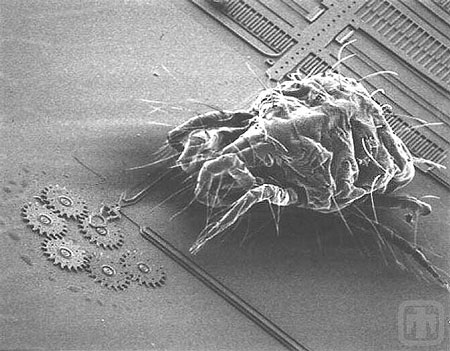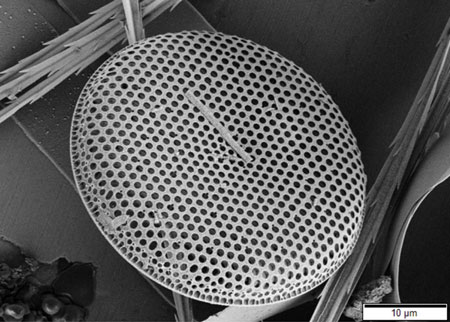2.2.1 Microelectromechanical systems (MEMS)
MEMS have feature sizes ranging from micrometers to millimeters. To see how small that is, consider that a regular sheet of paper is between 70 and 180 micrometers thick.
MEMS consist of any combination of mechanical (levers, springs, membranes, etc.) and electrical (resistors, capacitors, inductors, etc.) components to work as sensors or actuators.

For example, MEMS are used as accelerometers in modern automobile airbags where they sense rapid deceleration and, if the force is beyond a programmed threshold, initiate the inflation of the airbag.
The size of today's smartphones would be impossible without the use of numerous MEMS devices. Apart from accelerometers and gyroscopes, smartphones contain micro-mirrors, image sensors, auto-focus actuators, pressure sensors, magnetometers, microphones, proximity sensors and many more.
2.2.2 Nanoelectromechanical systems (NEMS)
With NEMS and other nanoscale devices we are getting into even smaller regions with length scales of nanometers (1 micrometer equals 1,000 nanometers). NEMS are not used in commercial applications yet but researchers are working on lab specimens. Among other things, NEMS are expected to provide nanoscale sensors, switches and resonators.
NEMS are so intriguing for researchers because they offer them access to otherwise difficult to measure or even entirely inaccessible scales: frequencies in the microwave range; active masses in the femtogram (10-15 grams) range; force sensitivities at the attonewton (10-18 newton) level; mass sensitivity at the level of individual molecules, heat capacities far below a yoctocalorie (10-24 calories) (see Nanoelectromechanical Systems, pdf). Check out our guide to metric prefixes for more details on the base units of measure.
In order to be able to measure the tiny forces of nanofriction that affect MEMS and NEMS, scientists employ extremely sensitive instruments in their experiments: scanning probe microscopy such as scanning tunneling microscopy (STM), atomic force microscopy (AFM) and lateral force microscopy (LFM), or friction force microscopy.
2.3 Learning from Nature
Nature has experimented with friction tuning systems at extremely small (i.e. nano) scales for millions of years. Scientists try to understand how these natural systems work and how they can be copied for man-made devices.
To do that, they analyze the frictional behavior of tiny organic objects like insects, bacteria, diatoms, and even DNA helices.
Especially diatoms, single-celled microalgae, are considered model systems for bio-nanotribological investigations (see: Biotribology at the micro- and nanoscale as exemplified by diatoms, pdf). Diatoms show highly efficient self-lubrication and their big attraction for science is that they are small, highly reproductive, and accessible with different kinds of microscopy methods.

So it is no surprise that these structures have raised tremendous research interest and have become an important area for nanoscientists. These investigations have led to a number of proposals for ways to reduce friction on the nanoscale, such as structuring surfaces with nanopatterns.
Already, advances in micro- and nanoscale manufacturing have allowed the fabrication of artificial surfaces that match and in some rare cases even surpass the performance of biological designs.
2.4 Superlubricity
A particularly intriguing case where friction almost vanishes is a phenomenon known as superlubricity, in which surfaces simply slide over each other with barely any resistance (a state that is called near-zero friction).
To date, however, most of the superlubricity observed experimentally has been realized only at the nanoscale and under extreme conditions like high vacuum or by using repulsive van der Waals forces. It therefore isn't really suitable for real world applications yet.
The difficulty of achieving superlubricity in mechanical systems is due to the very complex physical, chemical, and mechanical interactions that occur simultaneously at the sliding interfaces of these systems.
Recent advances in two-dimensional (2D) materials, such as graphene, (but also hexagonal boron nitride, molybdenum disulfide, and other 2D materials) have excited the tribology community because the excellent tribological properties of these materials lower friction to superlubric regimes. This opens the real possibility of creating atomically thin solid lubricants.
Take graphene – an atomic-scale honeycomb lattice made of carbon atoms – that is a promising lubricant because the friction between sheets is minuscule under certain circumstances. For instance, scientists have found ultralow friction when dragging graphene nanoribbons across a gold surface using an atomic force microscope. This discovery sets up the potential for developing graphene-based near frictionless coatings.
Using these 2D materials, and combinations of them, researchers are experimenting with their excellent tribological properties to explore if the superlubricity mechanisms can be realized across length scales, thus breaking old barriers that were restricting this effect to only nano- and microscale.

Achieving near-zero friction in commercial and industrial applications will be game-changing from tiny microelectromechanical systems that will never wear out, to oil-free bearings in industrial equipment, to much more efficient engines and giant wind turbines scavenging energy even in low wind conditions.
